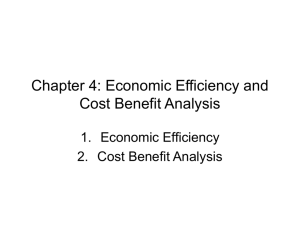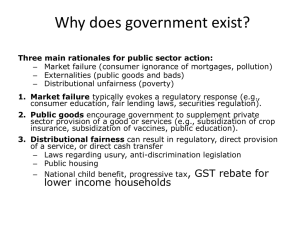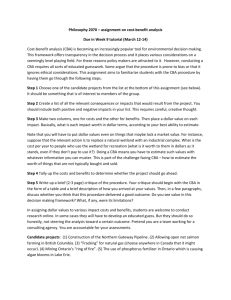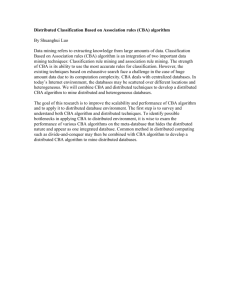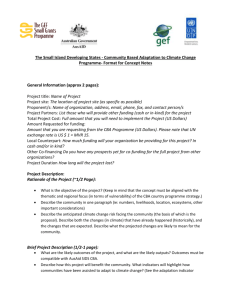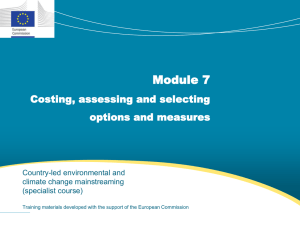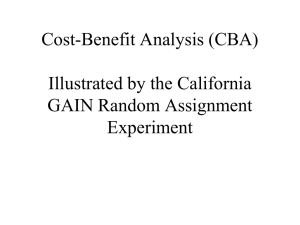Health Economics ch14
advertisement
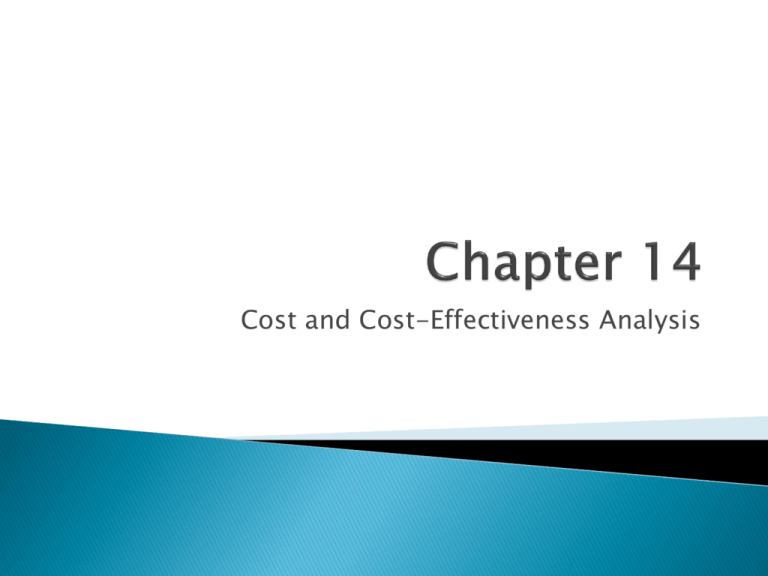
Cost and Cost-Effectiveness Analysis Public and private resources limited. Decisionmakers make choices about resource allocation; it is only a question on what basis such choices made. In public sector, policymakers often focus exclusively on costs or even on one type of cost, e.g., for drugs Private sector not better, e.g., cover if drug is safe and effectiveness or non-experimental or set copays to favor generic even if branded drug more cost-effective CBA/CEA provides a consistent framework for evaluating alternatives Helps separate use of objective empirical evidence from subjective value judgments Underlying calculations far too complex to be done in decision-maker’s head CBA/CEA are formal methods for comparing costs and benefits of a medical intervention to determine whether the intervention worth doing CEA measures benefit in terms of clinical outcome, e.g., mortality, blood pressure, time to reoccurance of cancer, quality-adjusted life years (QALYs) CBA measures benefit in terms of money, e.g, value of life-years saved, dollar outlays averted (value of reductions in readmissions to hospitals) Analysis does not give decision maker full evidence on alternatives Populations are heterogeneous: evidence on which CBA/CEA is based may not apply to decision-maker’s population Long-run effects not adequately documented Outcomes measured not relevant to decisionmaker Decision-maker does not have adequate technical knowledge to evaluate strengths and weaknesses of studies Quality of evidence underlying calculations question Study uses wrong perspective for decision-maker (relevant costs, benefits excluded, irrelevant costs, benefits included). Study method insufficiently transparent to make corrections Define the intervention Identify relevant costs Identify relevant benefits Measure costs Measure benefits Account for uncertainties Societal perspective ◦ all costs and effects (benefits) included no matter who pays costs or receives effects (benefits) Patient and patient family perspective Self-insured employer perspective Public or private insurer perspective Hospital perspective CEA seen as more practical, willingness to pay hard to measure accurately, and CBA violates distributional decision-maker’s distributional objectives CBA much more widely used in environmental policy/economics. Why? Benefit in CBA based on maximum willingness to pay (WTP) for a particular outcome More affluent likely to have higher WTP—irrespective of how WTP measured (using revealed preference approach or stated preference approach) When does cost measure not equal opportunity cost? ◦ Hospital excess capacity (beds) Patient out-of-pocket costs Government agency receives services from another agency Not all direct costs need to be positive: consider cost offsets Direct costs include value of all goods and services consumed in provision of the intervention or in dealing with side effects or other current or future consequences of intervention—health care costs and non-health care costs (child care when attending smoking cessation clinic, transportation costs to clinic, time lost from work when receiving intervention) Indirect costs=productivity costs Include morbidity costs, mortality costs, friction costs associated with productivity changes=cost of replacing an ill worker Indirect costs logically belong in denominator of cost-effectiveness ratio—danger of double-counting In CBA, also have to avoid double-counting—need to ask what is in willingness to pay measure Transfer costs Future costs Sunk versus incremental costs Joint costs/joint production To compute benefit, need to know whether or not a technology is effective and if so, how effective it is Letting X be the level of the input and Y be the level of the outcome, we need to evaluate Y=f(X) Need to test the null hypothesis that X has no effect on Y as well as evaluate magnitude of response Evidence on effectiveness may be in form of a probability of an effect of X on Y, difference in mean values of Y for different X, a marginal effect of X on Y from a regression, etc. Effectiveness v. efficacy. Efficacy refers to the effect of a technology when applied in optimal or ideal way. Effectiveness gives effect of technology when applied as people actually apply it. Valid estimate. The estimate is an unbiased measure of the technology’s true effectiveness. Reliable estimate. The result can be reproduced. Mortality QALY: How derived? Rating scales; standard gamble approach Category scale: present rater with scenario; rate on ladder from 0 (= to death) to 10 (=completely well), 5 (half way in between), etc. Visual analogue method: rater shown line, 100 centimeters in length, with end points well defined. Rater marks line to indicate where his or her preference is. Approach also applied to obtain subjective probabilities (“On scale of 0 to 10, what would you say is the likelihood that you will live to age 75?” State of disability (Utility = Ud) (Current Status) Healthy (Utility = Uh) (Success) Dead (Utility = 0) (Failure) Subject given choice of living for a defined amount of time in perfect health or a variable amount of time in another health state that is less desirable Reduce time in well state leaving time in suboptimal state fixed to establish point of indifference Fig. 14.2. Decision Making under Time Trade-off Utility Value Option 2 Healthy Uh State of disability (Current status) Ud Dead 0 Option 1 Time X T Yes Results highly variable, but there are differences among studies in health states valued, populations surveyed, etc. (see Sloan, ed., Chapter 3, Table 3.1) Recommend: select approach that makes most sense conceptually, pretest questions, perform sensitivity analysis Economists complain that utilities must be derived from explicit tradeoff questions which rating scale approaches do not do Psychologists say that approaches such as standard gamble too complex for respondents, tradeoffs too artificial. Cite some evidence validating their approaches Economists have spent less effort to date in validation DALYs Days lost due to illness Incidence of specific illnesses Physical functioning: number of Activities of Daily Living (ADL) limitations; Number of Instrumental Activities of Daily Living (IADL) limitations Cognitive impairment Depression (CES-D) Disability-adjusted life year (DALY): used to calculate the global burden of disease. A DALY = is 1 lost year of “healthy” life. Summing DALYs for a given population provides estimate of difference between current health status and an ideal health situation in which the entire population lives to an advanced age, free of disease and disability DALYs for a disease or health condition are calculated as ◦ sum of the Years of Life Lost (YLL) due to premature mortality in population and Years Lost due to Disability (YLD) for incident cases of the health condition: DALY =YLL + YLD where YLL = number of deaths multiplied by the standard life expectancy at the age at which death occurs YLD = product of ◦ the number of incident cases and disability weight for each disease and mean duration of the case until remission or death in years, (whichever occurs first) Virtually all decisions to be analyzed involve costs and benefits accruing over several years Principle of discounting that costs and benefits accruing later should receive less weight than those accruing earlier Process of discounting applies to all economic decisions, of which medical decisions are subset Issue is not whether or not to discount (little issue on discounting health outcomes in CEA), but rather which discount rates to use Pharmaceutical products for treating hypertension and cancer have long-run effects on health As does choice of diet, exercise, smoking, excess alcohol consumption As do treatments for heart disease, e.g., coronary bypass surgery Consider accelerating approval of an AIDS drug In perfectly competitive, risk-free, tax-free world in which output can be perfectly traded across periods, there would be only one interest rate. This rate would reflect (1) marginal rate of time preference—time trade-off rate for consumers and (2) marginal rate of return on investment—time trade-off in production (tangency). Generally thought to be real rate of 1-3% (with truly risk-free being 1% and allowing for some market but no credit risk more nearly 3%)
